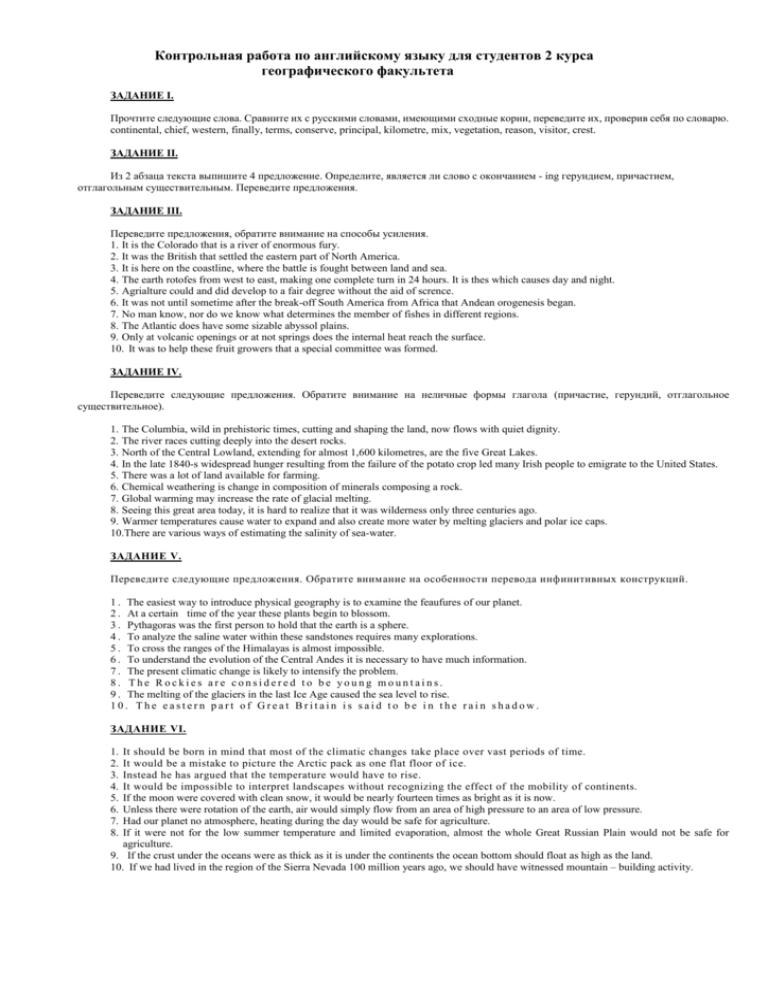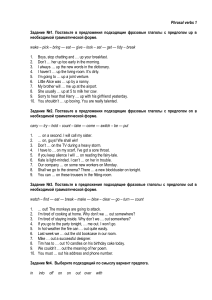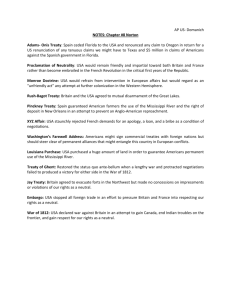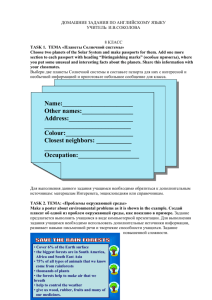Geography Control Work for College Students
advertisement

Контрольная работа по английскому языку для студентов 2 курса географического факультета ЗАДАНИЕ I. Прочтите следующие слова. Сравните их с русскими словами, имеющими сходные корни, переведите их, проверив себя по словарю. continental, chief, western, finally, terms, conserve, principal, kilometre, mix, vegetation, reason, visitor, crest. ЗАДАНИЕ II. Из 2 абзаца текста выпишите 4 предложение. Определите, является ли слово с окончанием - ing герундием, причастием, отглагольным существительным. Переведите предложения. ЗАДАНИЕ III. Переведите предложения, обратите внимание на способы усиления. 1. It is the Colorado that is a river of enormous fury. 2. It was the British that settled the eastern part of North America. 3. It is here on the coastline, where the battle is fought between land and sea. 4. The earth rotofes from west to east, making one complete turn in 24 hours. It is thes which causes day and night. 5. Agrialture could and did develop to a fair degree without the aid of scrence. 6. It was not until sometime after the break-off South America from Africa that Andean orogenesis began. 7. No man know, nor do we know what determines the member of fishes in different regions. 8. The Atlantic does have some sizable abyssol plains. 9. Only at volcanic openings or at not springs does the internal heat reach the surface. 10. It was to help these fruit growers that a special committee was formed. ЗАДАНИЕ IV. Переведите следующие предложения. Обратите внимание на неличные формы глагола (причастие, герундий, отглагольное существительное). 1. The Columbia, wild in prehistoric times, cutting and shaping the land, now flows with quiet dignity. 2. The river races cutting deeply into the desert rocks. 3. North of the Central Lowland, extending for almost 1,600 kilometres, are the five Great Lakes. 4. In the late 1840-s widespread hunger resulting from the failure of the potato crop led many Irish people to emigrate to the United States. 5. There was a lot of land available for farming. 6. Chemical weathering is change in composition of minerals composing a rock. 7. Global warming may increase the rate of glacial melting. 8. Seeing this great area today, it is hard to realize that it was wilderness only three centuries ago. 9. Warmer temperatures cause water to expand and also create more water by melting glaciers and polar ice caps. 10.There are various ways of estimating the salinity of sea-water. ЗАДАНИЕ V. Переведите следующие предложения. Обратите внимание на особенности перевода инфинитивных конструкций. 1 . The easiest way to introduce physical geography is to examine the feaufures of our planet. 2 . At a certain time of the year these plants begin to blossom. 3 . Pythagoras was the first person to hold that the earth is a sphere. 4 . To analyze the saline water within these sandstones requires many explorations. 5 . To cross the ranges of the Himalayas is almost impossible. 6 . To understand the evolution of the Central Andes it is necessary to have much information. 7 . The present climatic change is likely to intensify the problem. 8. The Rockies are considered to be young mountains. 9 . The melting of the glaciers in the last Ice Age caused the sea level to rise. 10. The eastern part of Great Britain is said to be in the rain shadow. ЗАДАНИЕ VI. 1. 2. 3. 4. 5. 6. 7. 8. It should be born in mind that most of the climatic changes take place over vast periods of time. It would be a mistake to picture the Arctic pack as one flat floor of ice. Instead he has argued that the temperature would have to rise. It would be impossible to interpret landscapes without recognizing the effect of the mobility of continents. If the moon were covered with clean snow, it would be nearly fourteen times as bright as it is now. Unless there were rotation of the earth, air would simply flow from an area of high pressure to an area of low pressure. Had our planet no atmosphere, heating during the day would be safe for agriculture. If it were not for the low summer temperature and limited evaporation, almost the whole Great Russian Plain would not be safe for agriculture. 9. If the crust under the oceans were as thick as it is under the continents the ocean bottom should float as high as the land. 10. If we had lived in the region of the Sierra Nevada 100 million years ago, we should have witnessed mountain – building activity. ЗАДАНИЕ VII. Прочтите и переведите устно весь текст. Кратко изложите письменно основные положения данного текста. THE RIVERS. The Mississippi is one of the world's great continental rivers, like the Amazon in the South America, the Congo in Africa, the Volga in Europe, or the Ganges, Amur, and Yangtze in Asia. Its waters are gathered from two-thirds of the United States and together with the Missouri (its chief western branch), the Mississippi flows some 6,400 kilometres from its northern sources in the Rocky Mountains to the Gulf of Mexico, which makes it one of the world's longest waterways. The Mississippi has been called the «father of waters". Through all its lower course, it wanders along, appearing lazy and harmless. But people who know the river are not deceived by its benign appearance, for they have had many bitter struggles with its floods. Finally, they had to learn that nothing was to be gained by fighting against the rages of the mighty streams. To tame it Americans have had to accept some of the river's own terms and to undertake the patient work of conserving and rebuilding soil, grasslands and forests, far back to where the waters begin to gather. Where the Missouri pours into the Mississippi from the west, it colors the river deep brown with small pieces of soil. Farther downstream, where the clear waters of the principal eastern tributary, the Ohio, join the Mississippi, evidence of the difference between the dry west and rainy east becomes apparent. For kilometres, the waters of the two rivers flow on side by side, without mixing. Those from the west are brown; they have robbed the soil in areas of sparse vegetation. The waters from the east are clear and blue; they come from hills and valleys where plentiful forest and plant cover has kept the soil from being washed away. Like the Mississippi, all the rivers east of the Rockies finally reach the Atlantic; all the waters to the west of the Rockies finally arrive at the Pacific. For this reason the crests of the Rocky Mountains are known as the Continental Divide. There are many places in the Rockies where a visitor may throw two snowballs in opposite directions and know that each will feed a different ocean. Приложение к контрольной работе по английскому языку для студентов 1 курса географического факультета (2 семестр) Climate 22. Прочитайте и переведите весь текст устно. Сделайте письменный перевод 4 абзаца. The climate in the UK is generally mild and temperate due to the influence of the Gulf Stream. The southwestern winds carry the warmth and moisture into Britain. The climate in Britain is usually described as cool, temperate and humid. The weather is so changeable that the English often say that they have no climate but only weather. Therefore it is natural for them to use the comparison as changeable as the weather of a person who often changes his mood or оpinion about something. The weather is the favourite topic of conversation in the UK. As the weather changes with the wind, and Britain is visited by winds .from different parts of the world, the most characteristic feature of Britain's weather is its variability. The English also say that they have three variants of weather: when it rains in the morning, when it rains in the afternoon or when it rains all day long. Sometimes it rains so heavily that they say ‘It's raining cats and dogs’. Rainfall is more or less, even throughout the year. In the mountains there is heavier rainfall than in the plains of the south and east. The driest period is from March to June, and the wettest months are from October to January. The average range of temperature (from winter to summer) is from 5 to 23 degrees above zero. During a normal summer the temperature sometimes rises above 30 degrees in the south. Winter temperatures below l0 degrees are rare. It seldom snows heavily in winter, frost is rare. January and February are usually the coldest months, July and August the warmest. Still the wind may bring winter cold in spring or summer days. Sometimes it brings whirlwinds or hurricanes. Droughts are rare. So, we may say that the British climate has three main features: it is mild, humid and changeable. That means that it is never too hot or too cold. Winters are extremely mild. Snow may come but it melts quickly. In winter the cold is a humid cold, not dry. This humid and mild climate is good for plants. Trees and flowers begin to blossom early in spring. 23. Найдите ответы на следующие вопросы в тексте: 1. 2. 3. 4. 5. 6. Why is the climate of Great Britain mild? The weather is stable in Britain, isn't it? What is the most characteristic feature of Britain's weather? Is the weather the most favourable topic of conversation? How can you describe the climate in Britain? Is this climate good for plants?











